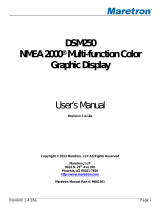
Revision 1.2 Page iii
Table of Contents
1 General ................................................................................................................................ 1
1.1 Introduction .................................................................................................................... 1
1.2 Firmware Revision ......................................................................................................... 1
1.3 Features ........................................................................................................................ 1
1.4 FFM100 Accessories ..................................................................................................... 1
1.5 Quick Install ................................................................................................................... 1
1.6 Theory of Operation ....................................................................................................... 2
1.6.1 Operating Modes ................................................................................................ 2
1.6.2 Sensor Accuracy ................................................................................................. 2
1.6.3 Diesel Fuel Flow Measurement ........................................................................... 4
1.6.4 Temperature Compensation ............................................................................... 5
1.6.5 Fuel Flow Sensor Selection ................................................................................ 6
1.6.6 Accuracy of Diesel Fuel Flow Measurement ....................................................... 7
1.6.7 Choosing a Fluid Flow Sensor Mounting Location .............................................. 8
2 Installation ............................................................................................................................ 8
2.1 Unpacking the Box ......................................................................................................... 8
2.2 Choosing a Mounting Location ...................................................................................... 8
2.3 Mounting the FFM100 .................................................................................................... 9
2.4 Mounting the Fluid Flow Sensor .................................................................................... 9
2.5 Connecting the FFM100 ................................................................................................ 9
2.5.1 Fluid flow sensor Connections ............................................................................ 9
2.5.2 NMEA 2000
®
Connection .................................................................................. 10
3 Configuring the FFM100 .................................................................................................... 11
3.1 Advanced Configuration .............................................................................................. 12
3.1.1 Configuring Device Instance ............................................................................. 12
3.1.2 Configuring Channel #0 Installation Orientation ................................................ 12
3.1.3 Configuring Channel #1 Installation Orientation ................................................ 12
3.1.4 Configuring Channel #0 Allow Negative Flow ................................................... 12
3.1.5 Configuring Channel #1 Allow Negative Flow ................................................... 13
3.1.6 Configuring Differential Mode Allow Negative Flow .......................................... 13
3.1.7 Configuring Installation Description ................................................................... 13
3.1.8 Configuring NMEA 2000 PGN Enable/Disable .................................................. 13
3.1.9 Restoring Factory Default Settings ................................................................... 13
3.2 Configuring the Device Label ....................................................................................... 13
3.3 Configuring the Operating Mode .................................................................................. 13
3.4 Configuring Channel #0 ............................................................................................... 14
3.4.1 Enabling/Disabling Channel #0 ......................................................................... 14
3.4.2 Configuring Channel #0 Engine Instance .......................................................... 14
3.4.3 Configuring Channel #0 Engine Label............................................................... 14
3.4.4 Configuring Channel #0 K-factor ....................................................................... 14
3.4.5 Configuring Channel #0 Data Damping Period ................................................. 14
3.4.6 Resetting the Total Volume Recorded for Channel #0 ...................................... 14
3.4.7 Configuring Channel #0 Temperature Instance ................................................ 14
3.4.8 Configuring Channel #0 Temperature Source ................................................... 14
3.4.9 Configuring Channel #0 Temperature Label ..................................................... 15




























